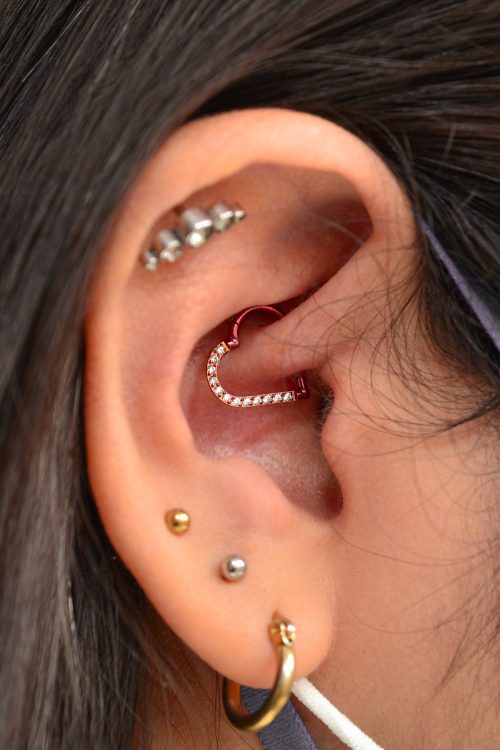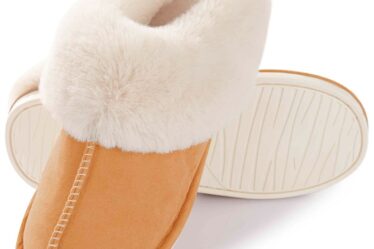
If you’re into piercings, then you’re likely always plotting your next jewelry-related move. Adding a new piece is like compiling a capsule wardrobe: You want each piercing to enhance the ones before it and add to an overall cohesive look. This search leads many people to daith piercings, which are piercings of the inner-ear cartilage.
Because daith piercings are less common than other types of piercings, like ones on the earlobe, prospective piercers often have lots of questions about them. Read on to learn everything you need to know about daith piercings, from how much it costs to get one to how long they take to heal to what other piercings they pair nicely with. You’ll want to think it through before heading to your nearest piercing studio.
RELATED: The 7 Luckiest Pieces of Jewelry You Can Wear, Experts Say.
What Is a Daith Piercing?
While many piercings are placed on the earlobe, daith piercings hug the inner cartilage of the ear, right above the ear canal. The word “daith” comes from the Hebrew word “da’at,” meaning “knowledge;” it was invented by piercer Erik Dakota and a Jewish client in 1992. The story goes that the client studied the Hebrew language and believed it’d take a knowledgeable piercer to complete a daith piercing.
According to Google Trends, daith piercings surged in popularity in 2015. Celebs like Miley Cyrus, Zoë Kravitz, Kylie Jenner, and Bella Thorne each have them, no doubt adding to their popularity. Some of the piercing’s rise to fame also comes from the claim they can stop migraines (more on that later!).
Does Getting a Daith Piercing Hurt?

Of course, no piercing is going to be as relaxing as getting a massage—but the pros say the daith piercing isn’t as painful as you might expect.
“The discomfort from receiving a daith piercing is comparable to that of other cartilage piercings of the ear,” says Ashley Sharp, senior director of piercing and innovation at Banter by Piercing Pagoda. “Though everyone experiences pain differently, I would rate the pain of a daith piercing as a 5 on a scale of 1 to 10.”
There are a few things you can do before your piercing to ease any discomfort. “Make sure you’re well-rested, hydrated, and have had a substantial meal before your appointment,” says Elin Sullivan, a professional piercer at The Circle London.
Soreness after a daith piercing is also to be expected, though avoiding touching the piercing, sleeping on it, and wearing hats and headphones can help minimize this.
How Much Do Daith Piercings Cost?
The cost of a daith piercing varies. Most start around $30, but pricing depends on where you get the piercing done; a piercing salon in one city might be more affordable than the next. The piercing itself likely won’t cost more than $80.
The jewelry you choose to put into your piercing will add to the total price of your appointment. “Implant-grade titanium, niobium, and solid 14k and 18k gold are all safe for initial piercings,” says Sullivan. You’ll want to ensure the metal is free of potential irritants like nickel.
Of those options, titanium and niobium are typically the most affordable. When getting your piercing, you’ll likely start with a small ring. These begin at around $50 and can get pretty pricey if your budget allows. If you opt for gold, expect a starting price higher than $100 for your jewelry.
Fortunately, this isn’t throw-away cash. “Your jewelry should last you a lifetime if cared for correctly,” says Sullivan.
That said, there are a few materials you should make certain to avoid, including plastic, surgical steel, and silver- or gold-plated items. “Although there are rare unicorn clients that can heal well with these materials, they often result in a plethora of issues that can easily be avoided with better quality jewelry,” says Sullivan.
RELATED: 3 Engagement Ring Styles to Avoid, Jeweler Says.
How Long Does it Take a Daith Piercing to Heal?


Daith piercing healing time varies from person to person, but most experts estimate it takes between six and 12 months, and sometimes even longer. “Even with a perfect aftercare and cleaning regime, they can be a little stubborn to heal,” says Sullivan.
How Can I Care for My Daith Piercing?
Piercing aftercare is key to ensure your piercing heals nicely—and as quickly as possible. There are three steps you’ll want to make sure to take.
Don’t Play With it Too Much
We know: This one’s easier said than done—but touching the piercing site can easily lead to an infection. “Hands carry a plethora of infectious microorganisms, and every time we touch our fresh piercing, we introduce these pathogens to our piercing,” says Sharp.
Touching the hoop could also lead to tears in the tissues that will become the piercing fistula (that’s the scar tissue tube that forms around the jewelry). “This further increases the risk that pathogens introduced to the area will cause infection,” adds Sharp.
You’ll also want to avoid accessories like headphones and earplugs, which can jostle the new piercing and introduce bacteria during the healing process.
Keep it Clean
Doing this is super easy with the use of a sterile saline solution, like H2Ocean, which should be readily available at your piercing studio. “You should liberally irrigate your piercing with the solution twice daily during your healing process,” says Sharpe.
Note that homemade saline solutions are not acceptable for use.
Keep it Dry
After cleaning your piercing, dry it with a clean paper towel. You should also avoid soaking in pools and hot tubs, which can expose your piercing to bacteria.
RELATED: The Best Color to Wear With Your Birthstone, According to Stylists.
When Can I Change My Daith Ear Piercing?
Because healing time differs from person to person, so will the timing of when you can change your piercing. You’ll want to wait for the full healing process of around six to 12 months. However: “I always recommend scheduling an in-person consultation with your piercing stylist before changing your piercing jewelry for the first time,” says Sharp. They can make certain the piercing is healed and help if any complications arise when switching the jewelry.
What Kind of Jewelry Can I Use for My Daith Piercing?


Because daith piercings are at a unique spot on your ear, you can only use certain types of earrings for them. The most popular types of daith jewelry include:
- Hoop rings: This is probably the type of jewelry you’ll get when you first get your daith pierced. It’s a traditional hoop like you’d expect for a lobe piercing.
- Curved barbells: This is a bit more minimalist; the barbell curves around the cartilage in a horseshoe shape, and two posts on either end keep it in place.
- Clicker rings: A clicker ring is a type of hoop that hinges open and shut, making it super easy to take on and off.
- Captive Bead Rings: This is a type of hoop that has a fixed bead that’s used to fasten the earring—it can be tricky to remove and might not be worth the investment for people who change their jewelry frequently.
Is It True That Daith Piercings Can Help Cure Migraines?
For the past several decades, daith piercings have been recognized by some proponents of alternative medicine as a possible cure for migraine pain. According to WebMD, the reasoning goes that the piercing impacts a section of the vagus nerve and that the pressure of having an earring in that area can work like acupuncture to block pain receptors in the body. Currently, there’s no proof that the piercing can do such a thing. However, some experts say the placebo effect may be strong enough that patients feel migraine relief, even if it’s not occurring due to the piercing.
What Other Piercings Can I Style With It?
- Rook piercings: This is another inner-cartilage piercing, which is located above the daith and pairs nicely next to it.
- Tragus piercings: The tragus is that little bump of cartilage that points inward toward your ear canal. Paired with a daith, it adds a nice sparkle to the inner ear.
- Lobe piercings: These are the piercings on your earlobe—having them in addition to a daith keeps your look balanced.
Conclusion
Ultimately, the decision to get a daith piercing is personal and one you’ll want to consult with a professional piercer on. Pain levels, healing time, and styling will vary from person to person—so make sure it’s the right fit for you.
For more beauty and jewelry news, visit Best Life again soon.
For more jewelry advice delivered straight to your inbox, sign up for our daily newsletter.



